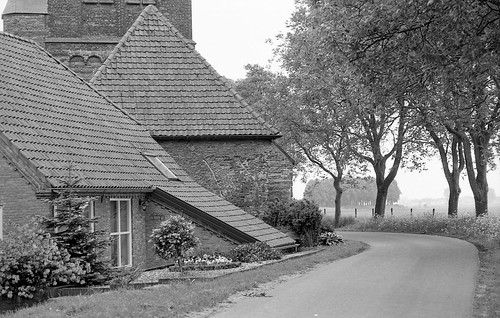jpa66
Jan as in "Jan and Dean"
I thought that Efke's quality control issues had been solved. I just developed two rolls of Efke 50 ( 120 ) and noticed after scanning that several photos had "specks" on them. At first I thought that they had been water spots, but upon close inspection of the negatives, they are obviously in the emulsion. Needless to say, it's very irritating.
Has anyone else had this problem recently? I really like the film, but I won't buy it again unless I can be assured that the emulsion isn't screwed up.
Jan
Has anyone else had this problem recently? I really like the film, but I won't buy it again unless I can be assured that the emulsion isn't screwed up.
Jan
Do these small specks have tails on them - making them look like comets?
braver
Well-known
I get the specks as well, looks like tiny circular pin prick holes in the emulsion
Leigh Youdale
Well-known
I did - a couple of years ago - and also on Fomapan. Threw quite a bit out as I wasn't prepared to have so many defective negatives. These days I stick to Ilford, Kodak or Fuji B&W films in that order of preference and don't fret about the higher prices. If you lose half your negatives to manufacturing defects then it's no longer cheap film!
sepiareverb
genius and moron
Are you using a wetting agent either before the developer or in it? This can usually eliminate pinholes completely. I use the Edwal version in the developer bath. The Rollei films were terrible in this regard here without it.
rogerzilla
Well-known
Pinholes aren't a great problem if you scan the negatives, since it's so easy to clone stuff out in Photoshop (or whatever). It is nice to get a clean neg that needs no retouching, though.
I assume you've ruled out bubbles sticking to the film, reticulation from going straight from the fixer to a very cold wash, etc?
I assume you've ruled out bubbles sticking to the film, reticulation from going straight from the fixer to a very cold wash, etc?
Fotohuis
Well-known
Black dots in an emulsion often appears due to metall ions (Iron) in the tap water.
White dots can often appears due to Calcium salts in the water. Ortho- and Orthopan films are more sensitive for this. Pin holes can be defects in the emulsion. In a rare case it can in theory caused by a very high pH developer followed by a too strong stop bath (>2%).
And yes, Efke (Fotokemika) in Croatia is running on very old machinery. Foma however (Czech Republic) have more modern machinery and an ISO qualification. Small problems in the past about the backing paper have been solved by using the better German backing paper now and take the regular hardening time for their emulsions.
Best way if you have a problem to take contact to the factory and send in some evidence material under mentioned batch number. Without this procedure it's a waste of time and only creating rumours on the internet.
Also Ilford/Harman was recently victim of a bad batch of ID11/Perceptol packings. Perforated packings with as result partial oxidized developer.
White dots can often appears due to Calcium salts in the water. Ortho- and Orthopan films are more sensitive for this. Pin holes can be defects in the emulsion. In a rare case it can in theory caused by a very high pH developer followed by a too strong stop bath (>2%).
And yes, Efke (Fotokemika) in Croatia is running on very old machinery. Foma however (Czech Republic) have more modern machinery and an ISO qualification. Small problems in the past about the backing paper have been solved by using the better German backing paper now and take the regular hardening time for their emulsions.
Best way if you have a problem to take contact to the factory and send in some evidence material under mentioned batch number. Without this procedure it's a waste of time and only creating rumours on the internet.
Also Ilford/Harman was recently victim of a bad batch of ID11/Perceptol packings. Perforated packings with as result partial oxidized developer.
jpa66
Jan as in "Jan and Dean"
I get the specks as well, looks like tiny circular pin prick holes in the emulsion
That's pretty much what mine look like ( no comet tail ).
Are you using a wetting agent either before the developer or in it? This can usually eliminate pinholes completely. I use the Edwal version in the developer bath. The Rollei films were terrible in this regard here without it.
I always use a wetting agent ( LFN in this case ) after the final wash, but never before development. What exactly does this do to the film that prevents the specks?
Pinholes aren't a great problem if you scan the negatives, since it's so easy to clone stuff out in Photoshop (or whatever). It is nice to get a clean neg that needs no retouching, though.
I assume you've ruled out bubbles sticking to the film, reticulation from going straight from the fixer to a very cold wash, etc?
While I scan all my photos, I only wet print the b&w stuff. And I make sure that the final rinse water is within a couple of degrees ( at most ) of the temp of the fix.
Black dots in an emulsion often appears due to metall ions (Iron) in the tap water.
White dots can often appears due to Calcium salts in the water. Ortho- and Orthopan films are more sensitive for this. Pin holes can be defects in the emulsion. In a rare case it can in theory caused by a very high pH developer followed by a too strong stop bath (>2%).
And yes, Efke (Fotokemika) in Croatia is running on very old machinery. Foma however (Czech Republic) have more modern machinery and an ISO qualification. Small problems in the past about the backing paper have been solved by using the better German backing paper now and take the regular hardening time for their emulsions.
Best way if you have a problem to take contact to the factory and send in some evidence material under mentioned batch number. Without this procedure it's a waste of time and only creating rumours on the internet.
Also Ilford/Harman was recently victim of a bad batch of ID11/Perceptol packings. Perforated packings with as result partial oxidized developer.
They are white dots ( to be quite general ) and not "black" ones. I did use tap water for everything but the wetting agent. Not trying to start internet rumors, just wanting to see if I did something wrong in development or if the emulsion's the problem. This has never happened before with any other films that I've developed, including the Fomapan stuff, so I want to find out if the problem's in my development process or not.
Fotohuis
Well-known
They are white dots ( to be quite general )
Efke 50 is an Orthopan film so it is extra sensitive for Calcium salts.
Try to make the developer in destilled water and also the last step with the wetting agent.
In 95% of the cases the white dot problem will be solved.
If you have a reel development you do not need necessary a hardener fixer but it's important to keep all temperatures during processing (incl. the wash) within 2C.
Efke emulsion is sensitive for reticulation. Also never sqeegee an Efke film neither develop above 24C.
Here an example of Efke 25 in 35mm. I am using a Britta (TM) filter. The Maxtra filter is pulling out most an- and kations followed by a fine carbon filter. Without filter: White dots on Ortho and Orthopan films. Black dots in micro films and in general drying marks on Synthetic film base. What a relief to get rid of all this crappy things.
Efke 25 E.I. 25 in Beutler 1+1+10 for 7:00 mintes at 20 C. M7 + Summarit 2,5/75mm.

sevo
Fokutorendaburando
Efke 50 is an Orthopan film so it is extra sensitive for Calcium salts.
My experience confirms that Efke might be calcium sensitive. But that won't be due to the sensitizing. Arguably the majority of Orthopan and Ortho films available in the last fifty years were vulnerable to dotting - but that will hardly have been due to their spectral response (they did not even use the same sensitizers across brands, types and times). The most likely culprit is their most obvious common characteristic - they are technical films. After panchromatic (and colour) firmly took over in pictorial photography, Ortho and Orthopan only survived in the technical niche, in high resolution, high contrast thin emulsion films. Technical thin emulsion films with entirely different spectral response share(d) the problem (for example the superpanchromatic Kodak Technical Pan or Efke IR), while I haven't seen Fuji Acros (the only orthopanchromatic pictorial film made in recent times) grow pinholes...
mathomas
Well-known
Efke makes gorgeous emulsions when they don't have defects. I love all speeds of it, but the quality has been a bit of a crapshoot for me.
Unfortunately I have had an ongoing problem with Efke 100 in 135. Tiny black dots on the negative that show as pure white "pinholes" on scans. Someone above said it's easy to spot scans. Well, not if there are hundreds, if not thousands of pinholes on a low-key image. I haven't had the same problem with Efke 25 or 50 in either 135 or 120. I had assumed I was doing something wrong with the 100/135, but I've had bad results even when using only distilled water processes, and with different developers.
Unfortunately, I've bought a couple of batches of rolls of 100/135 at different times. I haven't bought any more since last year. I suspect one my batches was bad, but now they're mixed up in the bin. I guess I need to toss all of it, but I just hate to throw film away .
.
Here's an example scan from last year (and I've done a lot of spotting to it already):

Really Should See Larger Size
Unfortunately I have had an ongoing problem with Efke 100 in 135. Tiny black dots on the negative that show as pure white "pinholes" on scans. Someone above said it's easy to spot scans. Well, not if there are hundreds, if not thousands of pinholes on a low-key image. I haven't had the same problem with Efke 25 or 50 in either 135 or 120. I had assumed I was doing something wrong with the 100/135, but I've had bad results even when using only distilled water processes, and with different developers.
Unfortunately, I've bought a couple of batches of rolls of 100/135 at different times. I haven't bought any more since last year. I suspect one my batches was bad, but now they're mixed up in the bin. I guess I need to toss all of it, but I just hate to throw film away
Here's an example scan from last year (and I've done a lot of spotting to it already):

Really Should See Larger Size
Last edited:
Share:
-
This site uses cookies to help personalise content, tailor your experience and to keep you logged in if you register.
By continuing to use this site, you are consenting to our use of cookies.

